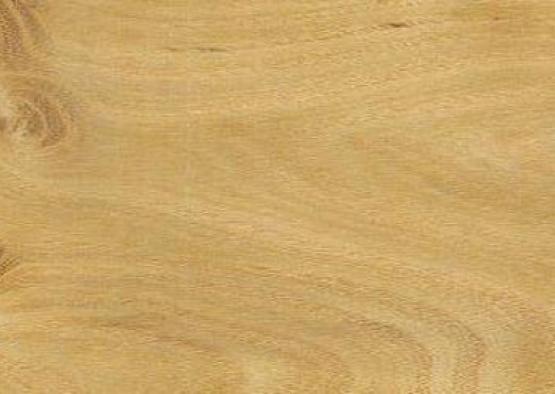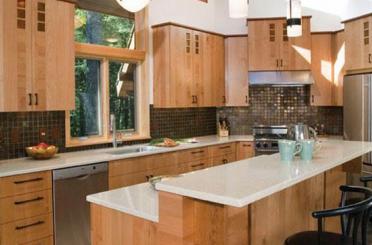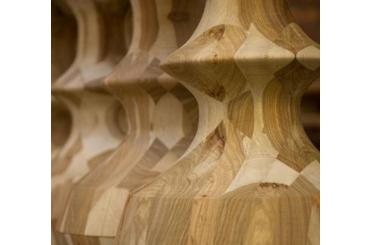Calantas is a medium-sized hardwood that grows in parts of South-East Asia including the Philippines, Malaysia and Indonesia. It is mainly used for decorative applications.
Kalantas, Limpoga, Surian, New Guinea Cedar, Surian Cedar, Cedrela Calantas
Toona calantas

Calantas is a medium-sized hardwood that grows in parts of South-East Asia, including the Philippines, Malaysia, Indonesia and Papua New Guinea. It is mainly used for decorative applications such as timber veneers, paneling, joinery and furniture. Other uses for calantas include boat building, piano cases and carving.
Its heartwood is reddish brown, while the narrow sapwood is generally a pale red in colour and quite distinctive. It is similar in appearance and also odour to Australian Red Cedar. Calantas has a moderately coarse texture with a grain that can be straight or interlocked.
Calantas is quite easy to work by hand or by machine, but tools need to be kept sharp, as the material can be soft. It is quick to dry, however there is a risk of internal checking and collapse. Issues may occur with gluing, painting and finishing for material where resin is present.
Small quantities of calantas are imported into Australia.
Shrinkage
| Very Low | Low | Medium | High | Very High | |
|---|---|---|---|---|---|

|

|

|
|||
Tangential : |
4.50%
|
||||
Radial : |
1.90%
|
||||
Unit Movement Tangential: |
0.24%
|
||||
Unit Movement Radial: |
0.15%
|
Strength Group

Very High |
High |
Reasonably High |
Medium High |
Medium |
Reasonably Low |
Low |
Very Low |
||
Unseasoned: |
S1 |
S2 |
S3 |
S4 |
S5 |
S6 |
S7 |
S8 |
|
|---|---|---|---|---|---|---|---|---|---|
 |
|||||||||
Seasoned: |
SD1 |
SD2 |
SD3 |
SD4 |
SD5 |
SD6 |
SD7 |
SD8 |
|
 |
Stress Grade

| Structural No. 1 |
Structural No. 2 |
Structural No. 3 |
Structural No. 4 |
Structural No. 5 |
|
Unseasoned: |
F8 |
F7 |
F5 |
F4 |
|
Seasoned: |
F11 |
F8 |
F7 |
F5 |
F4 |
Density per Standard

Seasoned: |
430kg/m3
|
|---|---|
Unseasoned: |
820kg/m3
|
Joint Group

Very High |
High |
Reasonably High |
Medium |
Low |
Very Low |
|
Unseasoned: |
J1 |
J2 |
J3 |
J4 |
J5 |
J6 |
|---|---|---|---|---|---|---|
 |
||||||
Seasoned: |
JD1 |
JD2 |
JD3 |
JD4 |
JD5 |
JD6 |
 |
Colour

| White, yellow, pale straw to light brown | Pink to pink brown | Light to dark red | Brown, chocolate, mottled or streaky | |
 |
||||
Mechanical Properties
Modulus of Rupture - Unseasoned: |
44
|
|---|---|
Modulus of Rupture - Seasoned: |
66
|
Modulus of Elasticity - Unseasoned: |
6.6
|
Modulus of Elasticity - Seasoned: |
8.2
|
Maximum Crushing Strength - Unseasoned:  |
22
|
Maximum Crushing Strength - Seasoned: |
41
|
Impact - Unseasoned: |
|
Impact - Seasoned: |
|
Toughness - Unseasoned: |
Low - up to 15 Nm
|
Toughness - Seasoned: |
Low - up to 15 Nm
|
Hardness - Unseasoned: |
3.2
|
Hardness - Seasoned: |
3.8
|
Durability
| Low | Moderate | Reasonably High | High | |
| (0 - 5 yrs) | (5 - 15 yrs) | (15 - 25 yrs) | (more than 25 yrs) | |
In-Ground: |
 |
|||
| (0 - 7 yrs) | (7 - 15 yrs) | (15 - 40 yrs) | (More than 40 yrs) | |
Above ground: |
 |
|||
| (0 - 20 yrs, usually < 5) | (21 - 40 yrs) | (41 - 64 yrs) | (More than 60 yrs) | |
Marine Borer Resistance: |
Lyctid Borer Susceptibility: |
Susceptible |
|---|---|
Lyctid Borer Susceptibility - Other: |
|
Termite Resistance: |
Fire Properties
| 1 - non-combustible | 2 - reasonably non-combustible | 3 - slightly combustible | 4 - combustible | |
Fire Properties Group |
Group Number - Other: |
3 if used on MDF or particleboard ≥12mm; veneer thickness 0.6-0.85mm
|
|---|---|
Average Specific Extinction Area: |
<250
|
Bushfire Resistance: |
Not Tested
|
Calantas is primarily an 'appearance timber'. Its heartwood ranges from a light red to a reddish brown, while the narrow sapwood is pale red or pinkish-grey in colour and quite distinctive. It is similar in appearance and also odour to Australian red cedar.
Calantas has a moderately coarse texture with a grain that can be straight or interlocked.
Calantas is used for decorative applications such as timber veneers, paneling, joinery and furniture. Other applications for calantas include boat building, piano cases and carving.
Calantas is quite easy to work by hand or by machine, but tools need to be kept sharp as the material can be soft. It is quick to dry, however there is a risk of internal checking and collapse.
Issues may occur with gluing, painting and finishing for material where resin is present.



